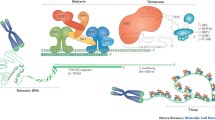Abstract.
Telomeres shield the ends of chromosomes from degradation and end-to-end fusions. They shorten at each cell division and when they reach a critically short length, cells arrest in the G1 phase of the cell cycle and undergo senescence. This effectively limits the proliferative potential of cells. Senescence functions as a tumour suppressor mechanism and appears to contribute to the process of ageing. If senescence is circumvented by tumour viruses, proliferation is re-initiated until cells enter crisis. Activation of telomerase prevents telomere attrition and cells become immortal. Cellular response to ionizing radiation involves induction of cell cycle checkpoint arrests and programmed cell death. Because radiation produces double strand breaks in DNA, which cause telomere-less chromosome ends, radiation response appears to be the result of inappropriate induction of cellular senescence mechanisms.
Similar content being viewed by others
Author information
Authors and Affiliations
Rights and permissions
About this article
Cite this article
Crompton, N. Telomeres, senescence and cellular radiation response. CMLS, Cell. mol. life sci. 53, 568–575 (1997). https://doi.org/10.1007/s000180050073
Published:
Issue Date:
DOI: https://doi.org/10.1007/s000180050073




